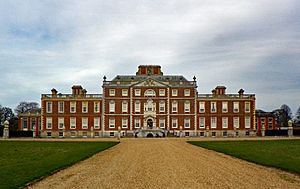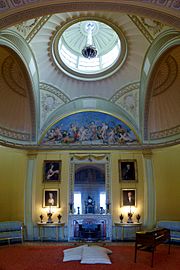Wimpole Estate facts for kids
Quick facts for kids Wimpole Hall |
|
|---|---|

The entrance front
|
|
| Type | Country house |
| Location | Wimpole |
| Area | Cambridgeshire |
| Built | 1640–1650 extended 1713-1716 remodelled 1742-1745 remodelled 1790-1794 remodelled c.1842 |
| Architect | James Gibbs Henry Flitcroft John Soane Henry Edward Kendall |
| Owner | National Trust |
|
Listed Building – Grade I
|
|
| Official name: Wimpole Hall | |
| Designated | 22 Nov 1967 |
| Reference no. | 1128166 |
| Official name: Wimpole Hall | |
| Designated | 16 January 1985 |
| Reference no. | 1000635 |
| Lua error in Module:Location_map at line 420: attempt to index field 'wikibase' (a nil value). | |
Wimpole Estate is a huge property in Cambridgeshire, England. It's about 9 miles southwest of Cambridge. The estate includes Wimpole Hall, a beautiful country house. The house was started in 1640. Its 3,000 acres of parkland and farmland are owned by the National Trust.
Wimpole is special because it's the only place owned by the National Trust that has a working farm. This farm, called Home Farm, is one of the biggest places in the UK for rare farm animals. The estate is usually open to everyone. In 2024, over 370,000 people visited Wimpole.
Contents
History of Wimpole Estate
Wimpole is located near an old Roman road called Ermine Street. It was first mentioned in the Domesday Book in 1086. Back then, it had a manor house with a moat. It was surrounded by a small deer park. There were also three medieval villages nearby.
Early Owners and Changes
The Chicheley family owned the estate for over 250 years, starting in 1428. Henry Chichele, who was Archbishop of Canterbury, was the first owner from this family. The last Chicheley to own the house was Thomas Chicheley. He was a politician and finished building the "new" house in 1650. He also created the formal gardens.
Thomas Chicheley enjoyed the house for 36 years. But he had money problems and had to sell it. In 1686, he sold it to Sir John Cutler. Sir John later gave it to his daughter Elizabeth and her husband, Charles Robartes, 2nd Earl of Radnor. Lord Radnor made the gardens even bigger and dug fishponds.
After Elizabeth died in 1697, the estate went to Edmund Boulter. Then, in 1710, it was owned by John Holles, 1st Duke of Newcastle-upon-Tyne. When he died, his daughter, Henrietta Harley, Countess of Oxford and Countess Mortimer, inherited it. In 1713, when Henrietta married Edward Harley, 2nd Earl of Oxford and Earl Mortimer, Wimpole became his.
In 1740, Edward Harley sold Wimpole to Philip Yorke, 1st Earl of Hardwicke. He needed to pay off his debts. The Earls of Hardwicke owned the estate for a long time. Later, it passed to Thomas Agar-Robartes, 6th Viscount Clifden, and then his son, Francis Agar-Robartes, 7th Viscount Clifden. In 1930, Francis moved away after his father passed away.
Royal Visit and New Owners
On October 27, 1843, Queen Victoria and Prince Albert visited Wimpole Hall. They listened to speeches and had dinner with 26 guests. A ball was held in the evening. The next morning, Queen Victoria visited the farm before leaving for London.
In 1942, Captain George Bambridge and his wife, Elsie Bambridge, bought Wimpole. Elsie was the daughter of the famous writer Rudyard Kipling. They had been renting the house since 1938. They used money from her father's inheritance and book royalties to fix up the house and grounds. During World War II, for example, the house didn't even have running water or electricity.
Elsie Bambridge was known for getting annoyed when people picnicked too close to the house. She once even had her own picnic on an offending couple's lawn! When Elsie Bambridge died in 1976, she left Wimpole Hall to the National Trust.
Exploring Wimpole Hall
Many famous architects worked on Wimpole Hall over the years. These included James Gibbs (from 1713 to 1730), Henry Flitcroft (around 1749), John Soane (in the 1790s), and H. E. Kendall (in the 1840s). The painter James Thornhill created beautiful decorations in 1721.
In 2014, marble statues of Roman emperors, Trajan and Galba, were brought back to Wimpole. They were placed on their original wooden stands. These stands were carved for them around 1860.
The Wimpole Estate Grounds
The grounds of Wimpole Hall were first enclosed in 1302. Over time, many famous landscape designers shaped them. These included George London and Henry Wise (1693–1705), Charles Bridgeman (1720s), Robert Greening (1740s), "Capability" Brown (1767), and Humphry Repton (1801–1809).
Charles Bridgeman designed a long, straight avenue that stretches for two and a half miles from the front of the house. This is very different from the rest of the park, which was made to look more natural by Capability Brown. The elm trees in the avenue were lost to disease, but new trees have been planted.
Features of the North Park
The North Park has areas of woodland. Its main attractions include the neo-Gothic Tower, also known as Wimpole's Folly (built in 1768). There are also restored lakes in the valley below. You can find St Andrew's church (from 1749), a home farm (from 1792), and a walled garden (from the 18th century). The stable block was built in 1851.
The "Dutch Garden" near the hall was created in 1980. The rest of the garden was finished to look like a mid-19th-century flowerbed.
Nature and Farming at Wimpole
In 2022, a huge tree planting project took place. The goal is for the estate to produce no net carbon emissions. About 90,000 trees were planted. These included 14 types of native trees like oak, hornbeam, and birch. Ten types of shrubs were also planted.
The walled garden at Wimpole uses organic farming methods. It grows crops, and some of these are given to a local food bank. In 2023, a survey found 77 different kinds of daffodils. Daffodils were the favorite flower of Elsie Bambridge, Wimpole's last private owner. In December 2019, the farm tested a robot that maps weeds. The National Trust plans to use this battery-powered robot during the growing season.
Activities at Wimpole
Wimpole Estate offers many fun activities. In 2013, the National Trust teamed up with parkrun to start a free, weekly 3.1-mile run. Every year, there's also a special illuminated trail called Christmas at Wimpole.
Important Buildings and Structures
Wimpole Park Estate has many "listed buildings" and structures. This means they are important historical places that are protected. Wimpole Hall itself is a neo-classical building and is Grade I listed. The entire estate is also Grade I listed on the Register of Historic Parks and Gardens.
The entrance gates at the west side of the hall are listed Grade II. The stable block is listed Grade II*. In the gardens, there are five vases and a copy of the sculpture Samson Slaying a Philistine that are listed Grade II. The steps to the west of the hall and the wall and railings to the south are also listed Grade II.
On the edge of the ornamental gardens, the ha-ha (a hidden ditch) to the north west and north are both listed Grade II. Wimpole's Folly, the castle-like building on the estate, is listed Grade II*. The walled garden and the gardener's cottage are both listed Grade II. The game larder (a cool storage room) to the north east of the hall is also listed Grade II.
Gallery
-
Wimpole's Folly, designed in 1751, looks like a medieval castle ruin













